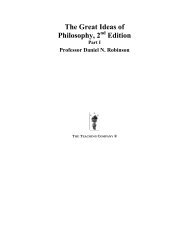English idioms in the first language and second language lexicon: a ...
English idioms in the first language and second language lexicon: a ...
English idioms in the first language and second language lexicon: a ...
Create successful ePaper yourself
Turn your PDF publications into a flip-book with our unique Google optimized e-Paper software.
338 <strong>English</strong> <strong>idioms</strong> <strong>in</strong> <strong>the</strong> L1 <strong>and</strong> L2 <strong>lexicon</strong>participants were asked to give a dichotomous decision, i.e., todecide whe<strong>the</strong>r <strong>the</strong>y judged <strong>the</strong> idiom to be decomposable ornondecomposable. The <strong>in</strong>structions <strong>first</strong> <strong>in</strong>troduced <strong>the</strong> term idiom<strong>and</strong> told <strong>the</strong> participants that <strong>the</strong> booklet lists <strong>idioms</strong> <strong>and</strong> <strong>the</strong>irparaphrases. Then <strong>the</strong> participants were given <strong>the</strong> follow<strong>in</strong>g<strong>in</strong>structions, which were a very close translation of <strong>the</strong> <strong>in</strong>structionsused by Titone <strong>and</strong> Conn<strong>in</strong>e (1994: 256), who took <strong>the</strong>ir <strong>in</strong>structionsdirectly from Gibbs <strong>and</strong> his colleagues (see, for example, Gibbs <strong>and</strong>Nayak, 1989: 108–09):Your task is to sort <strong>the</strong> follow<strong>in</strong>g <strong>idioms</strong> <strong>in</strong>to two categories: <strong>idioms</strong> whose<strong>in</strong>dividual words contribute to <strong>the</strong>ir overall figurative mean<strong>in</strong>g (so-calleddecomposable <strong>idioms</strong>) <strong>and</strong> <strong>idioms</strong> whose <strong>in</strong>dividual words do not contribute to<strong>the</strong>ir overall figurative mean<strong>in</strong>g (so-called nondecomposable <strong>idioms</strong>). Anexample of a decomposable idiom would be play <strong>the</strong> market, which means ‘tryto make money on <strong>the</strong> stock market by buy<strong>in</strong>g <strong>and</strong> sell<strong>in</strong>g stocks’. The wordplay relates to ‘try to make money’, <strong>and</strong> market refers to <strong>the</strong> stock market. Anexample of a nondecomposable idiom would be chew <strong>the</strong> fat, which means ‘talkabout affairs or events, especially those of o<strong>the</strong>r people, <strong>in</strong> a careless way’. The<strong>in</strong>dividual word mean<strong>in</strong>gs do not relate to <strong>the</strong> mean<strong>in</strong>g of <strong>the</strong> idiom.Note that <strong>the</strong> example idiom, its constituents <strong>and</strong> <strong>the</strong> paraphrasewere given <strong>in</strong> <strong>English</strong>, although <strong>the</strong> rest of <strong>the</strong> <strong>in</strong>structions were <strong>in</strong>German. As mentioned above, <strong>the</strong> native participants <strong>in</strong> <strong>the</strong> studiesby Gibbs <strong>and</strong> Nayak (1989) <strong>and</strong> Titone <strong>and</strong> Conn<strong>in</strong>e (1994) had tosubdivide <strong>the</strong> <strong>idioms</strong> <strong>the</strong>y rated as decomposable <strong>in</strong>to normally <strong>and</strong>abnormally decomposable ones, thus creat<strong>in</strong>g a third category. Thenonnative study reported here was restricted to <strong>the</strong> <strong>in</strong>itial,dichotomous decision, because Titone <strong>and</strong> Conn<strong>in</strong>e’s results (1994)have conv<strong>in</strong>c<strong>in</strong>gly shown that this third category is awkward <strong>and</strong> ofvery low psychological plausibility.In order to rate <strong>the</strong> familiarity of an idiom, participants wereasked to use a 7-po<strong>in</strong>t scale. They were given a booklet that conta<strong>in</strong>ed<strong>the</strong> <strong>idioms</strong> <strong>and</strong> that started with <strong>the</strong> follow<strong>in</strong>g <strong>in</strong>structions:For each of <strong>the</strong> follow<strong>in</strong>g <strong>idioms</strong>, you will have to decide how well you know<strong>the</strong> mean<strong>in</strong>g of <strong>the</strong> idiom. Make your rat<strong>in</strong>gs on a scale of 1 to 7. A rat<strong>in</strong>g of1 would mean that you have absolutely no idea what <strong>the</strong> idiom means, a 4 thatyou are moderately certa<strong>in</strong> of what it means, <strong>and</strong> a 7 would <strong>in</strong>dicate that youknow exactly what <strong>the</strong> idiom means <strong>and</strong> could easily put it <strong>in</strong>to your own words.Aga<strong>in</strong>, <strong>the</strong> <strong>in</strong>structions were translated from Titone <strong>and</strong> Conn<strong>in</strong>e(1994: 255; for a detailed discussion of problems with <strong>the</strong>se<strong>in</strong>structions, see below). The <strong>in</strong>structions concluded by giv<strong>in</strong>g twoexamples. After <strong>the</strong>y had worked through <strong>the</strong> list of <strong>idioms</strong>, <strong>the</strong>participants were given an additional task which asked <strong>the</strong>m tochoose three of <strong>the</strong> <strong>idioms</strong> <strong>the</strong>y rated with 7 <strong>and</strong> to write down <strong>the</strong>mean<strong>in</strong>g of each idiom <strong>in</strong> <strong>the</strong>ir own words. Although this task wasDownloaded from http://slr.sagepub.com at Shanghai Jiaotong University on March 7, 2009














